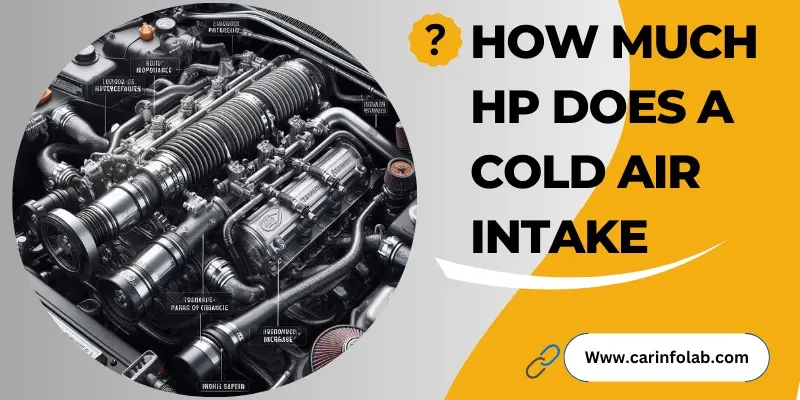How Much HP Does A Cold Air Intake Add Is It Worth It
Updated: August 31, 2024
126
When it comes to car modifications, a cold air intake is often one of the first upgrades enthusiasts consider. It’s relatively affordable, easy to install, and promises increased horsepower (HP). But how much HP does a cold air intake actually add? And is it worth the investment? If you make any mistake, it can cause a car to lose all electrical power.
In this article, we’ll break down the details, helping you understand the benefits, the limitations, and whether this upgrade is right for you.
What Is a Cold Air Intake?
A cold air intake is an aftermarket assembly of parts used to bring cooler air into a car’s internal combustion engine. It usually replaces the stock air filter and intake housing, which are designed to minimize engine noise but also restrict airflow. By increasing airflow and allowing the engine to “breathe” better, a cold air intake can improve engine performance.

How Does It Work?
The concept behind a cold air intake is simple. Cooler air is denser than warm air, meaning it contains more oxygen. More oxygen in the combustion chamber allows for a more powerful explosion, which can increase engine power. The intake system typically relocates the air filter outside the engine compartment, where it can draw in cooler air. This cooler, denser air results in better combustion and more power.
How Much HP Does a Cold Air Intake Add?
One of the most common questions about cold air intakes is how much horsepower they actually add. While results can vary depending on the vehicle and the specific cold air intake system, the general increase in horsepower is usually between 5 to 15 HP.
Factors Affecting the HP Increase
The actual horsepower gain from a cold air intake can depend on several factors:
- Engine Size: Larger engines can benefit more from increased airflow than smaller engines.
- Air Intake Design: Some cold air intakes are more efficient than others at delivering cool air to the engine.
- Vehicle Make and Model: Certain vehicles respond better to cold air intakes due to the design of their engine and intake system.
- Additional Modifications: If you have other engine modifications, such as an upgraded exhaust system, you may see even greater horsepower gains.
Is the HP Gain Noticeable?
A 5 to 15 HP increase may not sound like much, but it can be noticeable, especially when combined with other modifications. Drivers often report improved throttle response and acceleration after installing a cold air intake, even if the horsepower gain is modest.
Is a Cold Air Intake Worth It?
Deciding whether a cold air intake is worth the investment depends on your goals and expectations. For many drivers, the combination of improved throttle response, enhanced engine sound, and a modest HP increase is enough to justify the cost. However, if you’re expecting dramatic power gains, you might be disappointed.
Who Should Consider a Cold Air Intake?
- Car Enthusiasts: If you enjoy modifying your car and are looking for an affordable way to improve performance, a cold air intake is a good starting point.
- DIY Mechanics: If you like working on your car, a cold air intake is a relatively simple project that you can tackle yourself.
- Budget-Conscious Modders: For those looking for a cost-effective performance upgrade, a cold air intake offers good value for money.
Features, Benefits, and Price Comparison of Some Popular Cold Air Intake Brands
| Brand | Features | Benefits | Price Range |
|---|---|---|---|
| K&N | High-flow air filter, CARB-approved, million-mile warranty | Improved airflow, long-lasting durability | $150-$500 |
| AEM | DryFlow air filter, mandrel-bent aluminum piping | Enhanced throttle response, easy installation | $200-$400 |
| Injen | Dyno-tested, multiple finishes available | Maximum airflow, customizable appearance | $250-$550 |
| Spectre Performance | Affordable, high-quality construction | Budget-friendly, reliable performance | $100-$300 |
Who Might Want to Skip It?
- Daily Drivers: If you use your car primarily for commuting and are not interested in performance upgrades, a cold air intake may not be necessary.
- Drivers in Wet Climates: If you live in an area with frequent rain or flooding, the risk of water ingestion might outweigh the benefits of a cold air intake.
How to Choose the Right Cold Air Intake
If you’ve decided that a cold air intake is right for you, the next step is choosing the right one for your vehicle. Here are some tips to help you make the right choice:
1. Consider Your Vehicle’s Make and Model
Not all cold air intakes are created equal, and some are specifically designed for certain vehicles. Make sure you choose a cold air intake that is compatible with your car’s make and model.
2. Check the Material and Design
Cold air intakes come in various materials, including plastic, aluminum, and carbon fiber. Each material has its pros and cons, so choose one that fits your budget and performance needs. The design of the intake is also important; some designs are more efficient at delivering cool air than others.
3. Look for a Reputable Brand
When it comes to car parts, quality matters. Choose a cold air intake from a reputable brand that has good reviews and a history of producing reliable products. Brands like K&N, AEM, and Injen are well-known for their high-quality cold air intakes.
4. Consider the Filter Type
The air filter is a crucial part of the cold air intake system. Some intakes come with reusable filters that can be cleaned and reused, while others use disposable filters. Reusable filters are more cost-effective in the long run but require regular maintenance.
5. Price vs. Performance
While it’s tempting to go for the most expensive cold air intake, it’s important to balance price and performance. Sometimes, a mid-range option can offer the best value, providing good performance gains without breaking the bank.
Pros and Cons of Installing a Cold Air Intake
A cold air intake offers several benefits beyond just horsepower gains. Here are some reasons why you might consider this upgrade:
| Pros |
|---|
|
Enhanced Engine Sound
One of the side effects of installing a cold air intake is a change in the engine sound. With the stock air intake, the engine noise is often muffled by restrictive airboxes and resonators. A cold air intake opens up the airflow, allowing the engine to produce a deeper, more aggressive sound that many car enthusiasts love.
Potential for Better Fuel Efficiency
In some cases, a cold air intake can improve fuel efficiency. By allowing the engine to breathe more easily, it may not have to work as hard to produce the same amount of power, potentially leading to slight improvements in fuel economy. However, the difference is usually small and may vary depending on driving conditions and habits.

Cons
While there are several benefits to installing a cold air intake, there are also some drawbacks to consider:
| Cons |
|---|
|
Risk of Water Ingestion
One of the biggest risks with certain cold air intakes is water ingestion, also known as hydrolock. This occurs when the intake sucks in water instead of air, which can cause serious engine damage. This risk is higher if the air filter is positioned too low, such as near the front bumper or wheel well. In heavy rain or when driving through deep puddles, this can become a real concern.
Limited HP Gains
While a cold air intake can provide a noticeable improvement in performance, the horsepower gains are generally modest. If you’re looking for a significant power boost, you might need to consider additional modifications like a performance exhaust system, a turbocharger, or a supercharger.
Comparing Cold Air Intakes
| Feature | Plastic | Aluminum | Carbon Fiber |
|---|---|---|---|
| Weight | Light | Moderate | Very Light |
| Heat Resistance | High | Moderate | Very High |
| Durability | Moderate | High | High |
| Price | Low | Moderate | High |
| Performance | Moderate | High | High |
| Aesthetic Appeal | Low | High | Very High |
Conclusion
In conclusion, a cold air intake is a worthwhile upgrade for many drivers, especially those who enjoy working on their cars and are looking for a modest performance boost. While the horsepower gains are not massive, the improvement in throttle response, engine sound, and potential fuel efficiency make it a popular choice among car enthusiasts.
If you’re looking for an affordable, easy-to-install upgrade that can provide noticeable benefits, a cold air intake is definitely worth considering. For a seamless installation, understanding the F150 radio wiring diagram can help avoid potential issues during your vehicle’s modifications. Just be sure to choose the right intake for your vehicle and take the necessary precautions to avoid issues like water ingestion.
FAQs
How much HP does a cold air intake add to my car?
A cold air intake typically adds 5-20 HP to your car, depending on the make and model.
How much HP does a cold air intake contribute to engine performance?
A cold air intake can contribute 5-20 HP, enhancing overall engine performance.
How much HP does a cold air intake add for older cars?
Older cars may see a 5-15 HP increase with a cold air intake.
How much HP does a cold air intake give in a sports car?
In a sports car, a cold air intake can give a boost of up to 20 HP.
How much HP does a cold air intake offer over stock air intakes?
A cold air intake usually offers an additional 5-10 HP over stock air intakes.
Please Write Your Comments